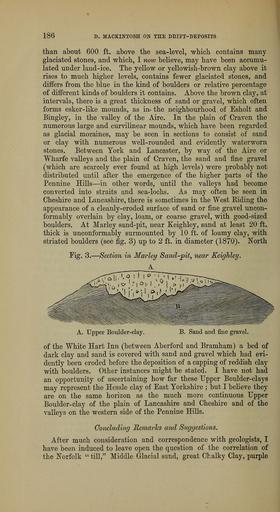MAKE A MEME
View Large Image

| View Original: | The_Quarterly_journal_of_the_Geological_Society_of_London_(12960478824).jpg (1750x3200) | |||
| Download: | Original | Medium | Small | Thumb |
| Courtesy of: | commons.wikimedia.org | More Like This | ||
| Keywords: The Quarterly journal of the Geological Society of London (12960478824).jpg 186 D MACKINTOSH ON THE DEIFT-DEPOSITS <br> than about 600 ft above the sea-level which contains many- <br> glaciated stones and which I noiu believe may have been accumu- <br> lated under land-ice The yellow or yellowish-brown clay above it <br> rises to much higher levels contains fewer glaciated stones and <br> differs from the blue in the kind of boulders or relative percentage <br> of different kinds of boulders it contains Above the brown clay at <br> intervals there is a great thickness of sand or gravel which often <br> forms esker-like mounds as in« the neighbourhood of Esholt and <br> Bingley in the valley of the Aire In the plain of Craven the <br> numerous large and curvilinear mounds which have been regarded <br> as glacial moraines may be seen in sections to consist of sand <br> or clay with numerous well-rounded and evidently waterworn <br> stones Between York and Lancaster by way of the Aire or <br> Wharfe valleys and the plain of Craven the sand and fine gravel <br> which are scarcely ever found at high levels were probably not <br> distributed until after the emergence of the higher parts of the <br> Pennine Hills- in other words until the valleys had become <br> converted into straits and sea-lochs As may often be seen in <br> Cheshire and Lancashire there is sometimes in the West Riding the <br> appearance of a cleanly-eroded surface of sand or fine gravel uncon- <br> formably overlain by clay loam or coarse gravel with good-sized <br> boulders At Marley sand-pit near Keighley sand at least 20 ft <br> thick is unconformably surmounted by 10 ft of loamy clay with <br> striated boulders see fig 3 up to 2 ft in diameter 1870 North <br> Fig 3 ” Section in Marley Sand-pit near Keighley <br> A <br> A Upper Boulder-clay B Sand and fine gravel <br> of the White Hart Inn between Aberford and Bramham a bed of <br> dark clay and sand is covered with sand and gravel which had evi- <br> dently been eroded before the deposition of a capping of reddish clay <br> with boulders Other instances might be stated I have not had <br> an opportunity of ascertaining how far these Upper Boulder-clays <br> may represent the Hessle clay of East Yorkshire ; but I believe they <br> are on the same horizon as the much more continuous Upper <br> Boulder- clay of the plain of Lancashire and Cheshire and of the <br> valleys on the western side of the Pennine Hills <br> Concluding RemarJcs and Suggestions <br> After much consideration and correspondence with geologists I <br> have been induced to leave open the question of the correlation of <br> the Norfolk till Middle Glacial sand great Chalky Clay purple 36090529 111264 51125 Page 186 Text 36 http //www biodiversitylibrary org/page/36090529 1880 Geological Society of London Biodiversity Heritage Library The Quarterly journal of the Geological Society of London v 36 1880 Geology Periodicals Smithsonian Libraries bhl page 36090529 dc identifier http //biodiversitylibrary org/page/36090529 smithsonian libraries Information field Flickr posted date ISOdate 2014-03-06 Check categories 2015 August 26 CC-BY-2 0 BioDivLibrary https //flickr com/photos/61021753 N02/12960478824 2015-08-26 16 56 10 cc-by-2 0 PD-old-70-1923 The Quarterly journal of the Geological Society of London 1880 Photos uploaded from Flickr by Fæ using a script | ||||